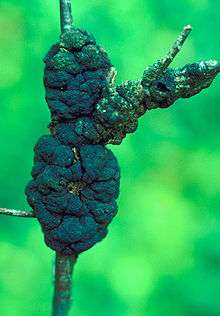Dibotryon morbosum
Dibotryon morbosum or Apiosporina morbosa is a plant pathogen, which is the causal agent of black knot.[1][2] It affects cherry, plum, apricot and chokecherry trees in North America. The disease produces rough, black growths that encircle and kill the infested parts, and provide habitat for insects.
| Dibotryon morbosum | |
|---|---|
 | |
| black knot on cherry | |
| Scientific classification | |
| Kingdom: | |
| Phylum: | |
| Subdivision: | |
| Class: | |
| Order: | |
| Family: | |
| Genus: | |
| Species: | D. morbosum |
| Binomial name | |
| Dibotryon morbosum | |
| Synonyms | |
| |
The disease was first described in 1821 in Pennsylvania, but has spread across North America. While it was one of the most destructive diseases of plum and cherry trees in the late 19th century, today it is relatively well controlled in many cultivated areas and seen primarily in poorly managed orchards, or where strongly established, including in the wild.
Black knot occurs only on the woody parts of trees, primarily on twigs and branches, but can spread to larger limbs and even the trunk. Olive-green swellings from the disease are visible in the late spring; as it spreads and matures, typically by autumn, rough black knots circle and kill affected parts. The knots vary in diameter from one inch to one foot (2.5 cm - 30 cm). Older knots can kill trees by promoting insect infestations.
The most common treatments are pruning infected parts during the winter and spraying buds with a fungicide. Nearby wild plants with the disease must also be treated.
Hosts and symptoms
Dibotryon morbosum affects the genus Prunus. Included in this genus are multiple species of trees and shrubs, though the ones that Dibotryon morbosum infects are Prunus serotina (wild cherry trees), Prunus Persica (peach trees), Prunus Domestica (plum trees), and Prunus cerasus (sour cherry trees)[3]. The main symptom of Dibotryon morbosum is its “knot-like” gall structure. These swellings often start as green in color, and become black the next season[4]. These knots can vary in size from anywhere to 0.5-12 in. long, and up to 2 in. wide[5]. This fungus is typically diagnosed by these large black galls at the site of infection.
Disease cycle
Dibotryon morbosum has a relatively simple disease cycle. In the spring, after overwintering in a previous host, the fungus produces ascospores, which are stored in pseudothecia[6]. These ascospores then get dispersed by the wind and rain until they find a susceptible host[7]. They typically infect their host on wounded tissue or shoots[8]. The infection is not systemic, but does grow and spread from the initial infection site. Symptoms are typically not noticeable in the season of initial infection, as the fungus grows inside the host. Throughout the summer, conidia are produced which also get dispersed by wind and rain. The conidia are asexual spores that help the fungus to spread within a given growing season[9]. The fungus then overwinters within the shoots and tissue of the host. It then produces ascospores in the spring to begin the cycle anew, but only after it has grown on its host for two winters[10]. It will not produce ascospores the first season after initial infection, but will continue to produce asexual conidia.
Management
There are several ways that Dibotryon morbosum is managed. The first way to manage this pathogen is to choose strains that are genetically resistant. There are several resistant species of the genus Prunus that can be used, such as Prunus maacki, Prunus armeniaca, and Prunus tribola[7]. Cultural management can also be used to help prevent Dibotryon Morbosum. Removing the source of inoculum, ascospores, by pruning plants can be effective in managing this fungus[10]. It is also important to consider where Prunus species are planted. Areas that are known to have had issues with Dibotryon morbosum should be avoided[10]. Chemical management can also be an effective way to manage Dibotryon morbosum. Fungicides can be used, but they are only recommended for use in severe cases, and are often not very effective unless used with other cultural methods[10]. Additionally, fungicides will only be effective if the source of inoculum is no longer present[3].
References
- Black Knot, Apiosporina morbosa at West Virginia University
- Distribution map of Apiosporina morbosa Archived 2007-09-27 at the Wayback Machine at European and Mediterranean Plant Protection Organization(dead link)
- "Black Knot (Apiosporina morbosa [syn. Dibotryon morbosum])-Hort Answers - University of Illinois Extension". web.extension.illinois.edu. Retrieved 2019-12-09.
- "black knot | Description, Symptoms, & Control". Encyclopedia Britannica. Retrieved 2019-12-09.
- "Black Knot: Apiosporina morbosa" (PDF). Cornell University Plant Diagnostic Clinic. Retrieved 2019-12-08.
- Wilcox, Wayne. "Black Knot of Plums" (PDF). Cornell University. Retrieved 2019-12-08.
- "Black Knot, Apiosporina morbosa". Master Gardener Program. Retrieved 2019-12-09.
- "Black Knot (Apiosporina morbosa [syn. Dibotryon morbosum])-Hort Answers - University of Illinois Extension". web.extension.illinois.edu. Retrieved 2019-12-09.
- "Access Library Resource - UW Libraries". patron.library.wisc.edu. Retrieved 2019-12-09.
- "Black knot". Black knot. Retrieved 2019-12-09.
External links
- Index Fungorum entry
- USDA ARS Fungal Database
- West Virginia University Black Knot page
- Ohio State University Extension, Black Knot Fact Sheet